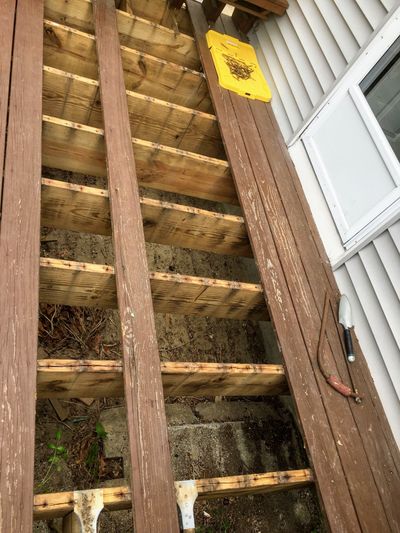Ask the Builder: Salvaging and restoring a wood deck

Q. I’ve got a 9-year-old treated lumber deck on my home that’s showing worrying signs of decay. I removed some of the deck boards and discovered that some of the 2-by-12s are rotting at the top, and there are huge cracks running along the top edge of each joist. Should I replace the entire deck and start over? Is there a way to salvage what I have? If you were here helping me, how would we make it so the deck would last 30 or 40 years? – Jeff Y., Upton, Mass.
A. Nine years old! I know this really dates me, but I remember the first time I saw an in-store marketing piece for treated lumber. I was fresh out of college and had just started my own remodeling business.
I was at the sales counter of a local full-service lumber company. This was four years before the major orange big-box store was even a glint in the eye of its founder. There on the counter was a color cardboard placard that introduced treated lumber with a LIFETIME GUARANTEE. I marveled – and swallowed it hook, line and sinker because I didn’t have enough life experience to know better.
I’ve since come to realize that some marketing managers for manufacturers live in a world populated with unicorns, rainbows and glitter. Some also distort the English language and play with semantics. Rhetorical question: “Whose lifetime?”
Here’s the truth. Treated lumber can and does decay. It can and does crack. Water is its enemy. Let’s do an autopsy on Jeff’s 9-year-old (gasp!) deck, hoping that you can avoid his pain, his upcoming labor and his possible expense.
Treated lumber is a magnificent material when you think about it. It used to be treated differently decades ago when I first bought it, but the EPA decided that the heavy metal chromium was not such a good idea in your life. Today, the treated lumber that you see at the home centers and lumberyards contains lots of copper, a very good natural biocide.
But the core issue with treated wood is that it’s hygroscopic. This means it changes its shape and size in response to the presence of water. If you have a piece of older treated lumber, you can do a fascinating experiment. Set it out in the sun and allow it to become dry as a bone. Once it’s dry, drop a small amount of water on it. Look closely and you’ll see the water soak into the lumber. Therein lies the problem.
The water causes the lumber to swell. As the wood dries, the lumber shrinks. This back-and-forth movement causes tension within the lumber, and micro-cracks start to develop. After repeated wet/dry episodes, the cracks grow to where you can see them. These are called checking cracks. These cracks allow the next rainfall to penetrate deeper into the wood, causing even greater tension forces. The cracks grow bigger and bigger.
Rot can happen for many reasons. When you purchase the treated lumber, you hope that the chemicals used were in the right proportion. You hope the pressure vessel the lumber was in was working right. You hope the pressure gauges were accurate. You hope the operator didn’t have a fight with his wife or boss that day. Hope is something you should reserve for things you can’t control, like the weather or your chances of being rescued from a deserted island.
If I could help Jeff rebuild his deck, here’s where I’d start. First, I’d buy my lumber from a true lumberyard, not a home center. You can get different grades of treated lumber, and I prefer No. 1 if I can get my hands on it. All I ever see at the home centers I visit is No. 2.
I’d be sure to use the absolute best metal framing connectors and fasteners that have been rated for use with modern treated lumber. Remember, today’s treated lumber has a very high concentration of copper in it. Once treated lumber gets wet, a chemical reaction begins, and the iron loses this battle. Many people have been injured or killed in deck collapses caused by the corrosion of the fasteners.
Once the undercarriage of the deck was complete, I’d cover the top of all the joists as well as the tops of any beams with the newer joist tape meant for this purpose. This tape seals the top of the joists and beams and minimizes the chances of water entering the lumber. It’s important to realize that when you drive a nail into the top of a treated lumber joist, you create stress points that eventually result in cracks around the nail shaft. The cracks allow the wretched water into the lumber with the aforementioned ill effects. The tape is designed to seal around the shaft of a deck nail or screw.
Jeff might be able to salvage all his current lumber. He might be able to flip over the joists. The issue might be that he’ll have to trim the lumber ever so slightly in case the joists are crowned. A crowned joist has a hump in it much like bridges you drive over. Crowns should point skyward. If you flip over a crowned joist, now it has a dip in it that can cause water to collect on the deck. The thing to do is snap a chalk line and cut out the dip.
I’d purchase some liquid copper naphthenate and brush it on any of the joists where the rot is less than 5% of its overall width. In my humble opinion, joists with more rot than this should be replaced.
Subscribe to Tim Carter’s free newsletter and listen to his new podcasts at askthebuilder.com.